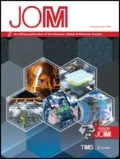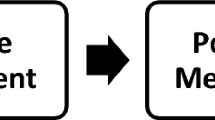Abstract
Casting designs are generally based on strength of materials calculations and the experience of the designer. This process leads to incremental development of designs utilizing factors of safety, which lead to increased component weights and inefficient use of materials. In castings, unquantifiable factors (such as shrinkage, porosity, hot tears, and inclusions) lead to conservative design rules. Non-destructive testing does not give the designer a way to assess the effect of indications on part performance. This article describes recent work to predict the occurrence and nature of defects in castings and determine their effect on performance.
Similar content being viewed by others
References
J. Campbell, Castings (Oxford, England: Butterworth-Heineman, 1991), pp. 273–283.
K. Carlson et al., Met. Trans. B, 33B (2002), pp. 731–740.
S. Ou et al., Met. Trans. B, 33B (2002), pp. 741–755.
K. Carlson et al., Int. J. Cast Metals Res., 14 (3) (2001), pp. 169–183.
K.D. Carlson et al., Modeling of Casting, Welding and Advanced Solidification Processes X, ed. D.M. Stefanescu et al. (Warrendale, PA: TMS, 2003), pp. 295–302.
K.M. Sigl et al., International Journal of Cast Metals Research, 17 (3) (2004), pp. 130–146.
R.I. Stephens, Fatigue and Fracture Toughness of Five Carbon or Low Alloy Cast Steels at Room or Low Climatic Temperatures (Des Plaines, IL: Carbon and Low Alloy Technical Research Committee, Steel Founders’ Society of America, 1982).
R. Hardin and C. Beckermann, “Effect of Shrinkage on Service Performance of Steel Castings” (Paper presented at the 56th Steel Founders’ Society of America National Technical & Operating Conference, Chicago, Illinois, 7–9 November 2002), p. 29.
R. Hardin and C. Beckermann, “Effect of Porosity on Mechanical Properties of 8630 Cast Steels” (Paper presented at the 58th Steel Founders’ Society of America National Technical & Operating Conference, Chicago, Illinois, 4–6 November 2004), p. 19.
W.D. Pilkey, Stress Concentration Factors, 2nd edition (New York: Wiley-Interscience, 1997), p. 349.
C.W. Briggs, Hot Tears in Steel Castings (Crystal Lake, IL: Steel Founders’ Society of America, 1968).
M. Rappaz, J.-M. Drezet, and M. Gremaud, “A New Hot-Tearing Criterion,” Metallurgical and Materials Transactions A, 30A (1999), pp. 449–455.
J. Campbell and T.W. Clyne, Cast Metals, 3 (1991), pp. 453–460.
C. Monroe and C. Beckermann, “Development of a Hot Tear Indicator for Use in Casting Simulation” (Paper presented at the 58th Steel Founders’ Society of America National Technical & Operating Conference, Chicago, Illinois, 4–6 November 2004).
J. Campbell, Castings (Woburn, MA: Butterworth-Heinemann, 1993), pp. 10–26, 53–63.
J.M. Svoboda et al., AFS Transactions, 95 (1987), pp. 187–202.
J.A. Griffin and C.E. Bates, Ladle Treating, Pouring and Gating for the Production of Clean Steel Castings, SFSA Research Report No. 104 (Crystal Lake, I: Steel Founders’ Society of America, 1991).
P. Scarber, Jr., C.E. Bates, and J.A. Griffin, “Using Gating Design to Minimize and Localize Reoxidation” (Paper presented at the 56th Steel Founders’ Society of America National Technical & Operating Conference, Chicago, Illinois, 7–9 November 2002).
N.W. Lai, W.D. Griffiths, and J. Campbell, Modeling of Casting, Welding and Advanced Solidification Processes X, ed. D.M. Stefanescu et al. (Warrendale, PA: TMS, 2003), pp. 415–422.
J.J. Runyoro, S.M.A. Boutorabi, and J. Campbell, AFS Transactions, 100 (1992), pp. 225–234.
C. Wanstall, J.A. Griffin, and C.E. Bates, “Water Modeling of Steel Pouring Practices” (Paper presented at the 47th Steel Founders’ Society of America National Technical & Operating Conference, Chicago, Illinois, November 1993).
K.D. Carlson and C. Beckermann, “Modeling of Reoxidation Inclusion Formation during Filling of Steel Castings” (Paper presented at the 58th Steel Founders’ Society of America National Technical & Operating Conference, Chicago, Illinois, 4–6 November 2004).
Author information
Authors and Affiliations
Additional information
For more information, contact Christoph Beckermann, University of Iowa, Department of Mechanical and Industrial Engineering, 2412 SC, Iowa City, IA 52242-1527; (319) 335-5681; fax (319) 335-5669; e-mail becker@engineering.uiowa.edu.
Rights and permissions
About this article
Cite this article
Blair, M., Monroe, R., Beckermann, C. et al. Predicting the occurrence and effects of defects in castings. JOM 57, 29–34 (2005). https://doi.org/10.1007/s11837-005-0092-3
Issue Date:
DOI: https://doi.org/10.1007/s11837-005-0092-3




